THE NAVY BICYCLE SQUAD OF BROOKLYN (1897)
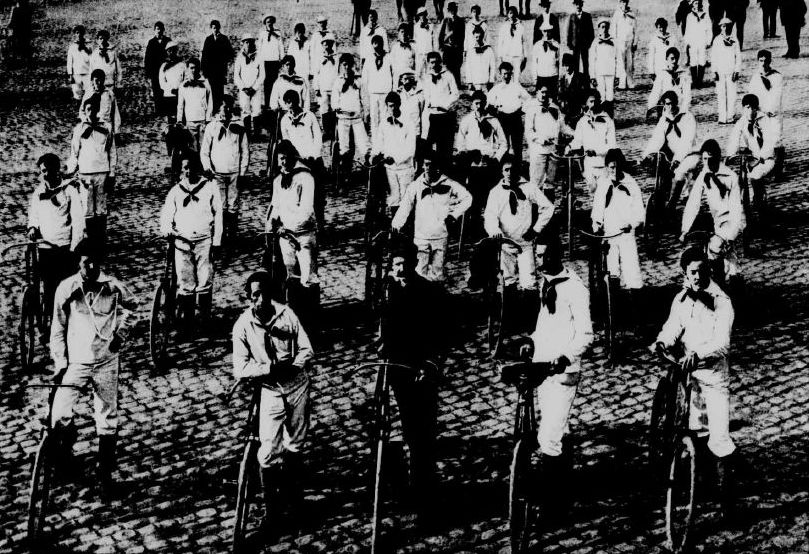
******************************************************************************************************************************** Brownstone Detectives investigates the history of our clients’ homes. The story you are about to read was composed from research conducted in the course of one of those investigations. Do you know the history of YOUR house? ******************************************************************************************************************************** Boy! But the Navy sure knew how to get around back in the day! These “wheelmen” – resplendent in their military uniforms – were organized not just for play, but for work. As bicycling was as much of a past time then as it is today, these men likely rode not only for their enjoyment, but to travel from station to station, as well – also representing the Navy in bicycling races. Headquartered at 56th Street in Brooklyn, the Second Naval Battalion was organized just before this picture was taken in July of 1897. It performed duty for the state during the Spanish-American war on coast signal service, guarding mine fields at Willets Point, in Queens, and on patrol duty in New York harbor aboard various vessels. From the New York Tribune of 4 July 1897, we have pictured above, “the first meet of the Bicycle Squad of the 2nd Naval Battalion at the Memorial Arch (Grand Army Plaza) in Brooklyn.” Follow @BrownstoneDetec Share ———————————————————————————————————————– The Brownstone Detectives Brownstone Detectives is an historic property research agency. Our mission is to document and save the histories of our clients’ homes. From our research, we produce our celebrated House History Books and House History Reports. Contact us today to begin discovering the history […]
THE FIRE AT NO. 382 PARK PLACE (1903)
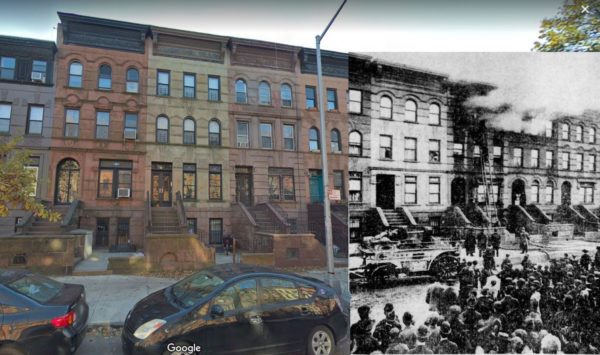
******************************************************************************************************************************** Brownstone Detectives investigates the history of our clients’ homes. The story you are about to read was composed from research conducted in the course of one of those investigations. Do you know the history of YOUR house? ******************************************************************************************************************************** All new homeowners begin their “home” journey with a blank slate. This is especially true in the case of owners of very old properties. They have very little information about the history of the structure they will be living in and nothing at all about the people who once lived there. When we meet with clients for the first time and reveal an important historical event involving their house, they begin to realize a very important historical tenet: Each house has a history. For one house, that history may include a tale about a runaway child. For another it could be a bankruptcy that led to a foreclosure on the home, followed by the family’s ignominious departure in the wee hours. For yet another, it may be a fire that almost destroyed the entire house that they had just purchased. For No. 382 Park Place, it was the flames. “THE FIRE CAUSED MUCH EXCITEMENT…” In a newspaper article accompanied by a picture of the firemen fighting the conflagration, the known details were spelled out – from the person who was home to how the fire was reported and what damage was done. “Fire broke out late yesterday afternoon in the house at 382 Park place and the work of the firemen […]
A RAILROAD FOR PARK SLOPE’S 8TH ST. (1904)
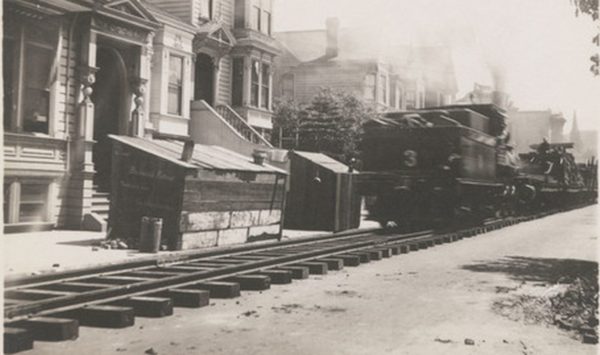
******************************************************************************************************************************** Brownstone Detectives investigates the history of our clients’ homes. The story you are about to read was composed from research conducted in the course of one of those investigations. Do you know the history of YOUR house? ******************************************************************************************************************************** Few of today’s Park Slope residents know about them. In early February of 1904, however, they suddenly appeared on Eighth Street between Prospect Park West and Eighth Avenue, an industrial omen in a white shoe neighborhood. These dark and foreign objects were a set of iron railroad tracks that had been – overnight – inserted coarsely into a place where they did not belong – residential suburbia. The block where these alien metals and wood had descended, had just barely been settled recently with homes (and even more recently with families). It had just seen itself partially developed with a row of eight upscale apartment houses on the north side of the street and 12 two-story & basement limestone houses on its south. With the recent spate of construction, there were – at the time the tracks appeared – a mere four families that had purchased “handsome houses” on the block, which they had taken possession of at “fancy prices.” Now, those with an interest on the block were showing “great alarm.” With the appearance of the tracks, residents fully expected their properties to be “ruined in value,” causing them to begin considering selling them at a discount and to ignominiously leaving the neighborhood. The builder of the limestones, Sen. William […]
COL. BACON KISSED THE WIVES (1905)

It is a shame the way newspaper reporters don’t write these days. The folksy, tongue-in-cheek, gossipy style of 100 years ago would today seem too daring, too familiar. And perhaps newspapers now are just a little too gun-shy of potential libel suits… Here is a story reported by the Brooklyn Daily Eagle in 1905, that combines all the elements of a ribald over-the-fence tittle-tattle: Brooklyn Daily Eagle, Fri., 20 October 1905 — The home makers and home defenders of Prospect Park South were stirred this morning to dark purposes. Quite well it was that Colonel Alexander S. Bacon got away from Ditmas Park home in that aristocratic section before his neighbors saw the morning papers in which the gallant colonel was depicted in the very act of kissing their wives. Not only that, but the same papers had Colonel Bacon declaring publicly that he had been enjoying sweet osculatory favors. It all grew out of Colonel Bacon’s law business. He was defending Mrs. Hortense Powers from the suit of her husband, William F. Powers, who wanted a divorce on the ground that Mrs. Powers had been too free with her kisses and favors for a neighbor, “Billy” Campbell. Colonel Bacon tried to excuse and justify these little tokens of affection. Here is the argument he was reported to have used before the jury: “Gentlemen, every one of you who is married probably has kissed his neighbor’s wife. Without wishing to be egotistical, I might say that I have been fortunate […]
SUBWAY DIGGING – GRAND ARMY PLAZA (1914)
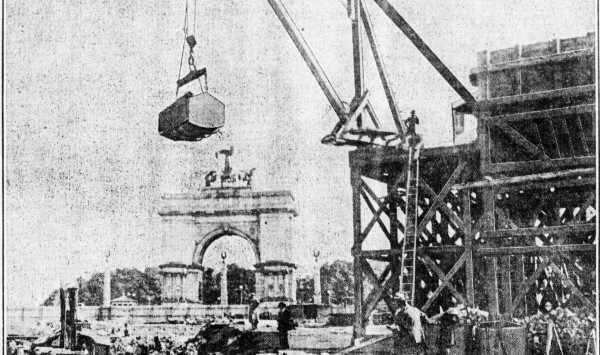
“Dirt is beginning to fly with telling effect in the excavations for the extension of the subway through Flatbush Avenue and out Eastern parkway,” noted the Brooklyn Daily Eagle in their 30 August 1914 edition. “The Above picture shows the big steam shovel at work close to the sailors and soldiers Monument at the Plaza of Prospect Park. Which is seen in the background. This excavation of the present subway will be constructed faster than the Fourth Avenue line has been because there are neither troubles about obtaining title to abutting lands nor the physical difficulties which reset the Fulton Street section of the Fourth Avenue line.” Follow @BrownstoneDetec ———————————————————————————————————————– The Brownstone Detectives The story you have just read was composed from extensive historical research conducted by The Brownstone Detectives. Our clients commission us to investigate the history of their – or their clients’ – historic properties. From our findings, we produce their very own hardbound House History Books. Our books are professionally written and laid out, containing illustrated and colorful narratives that bring the history of any house to life. Contact us today to begin discovering the history of your home.
THE SECOND HUMILIATION OF WARREN (1960)
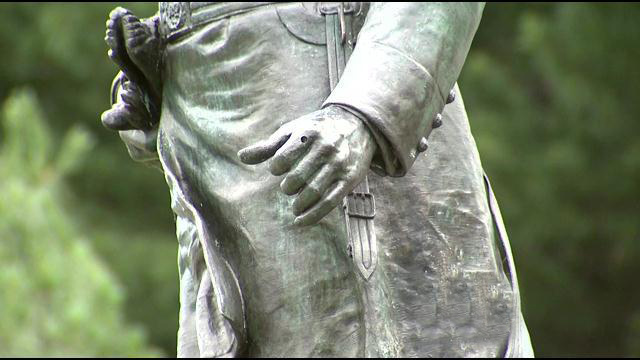
A number of New York City Parks Department statues are having their stolen swords replaced reported a DNAInfo story. The statues, most of which have had their their swords stolen (bayonets, and glasses, in some instances) during times of high crime, are now deemed worthy of replicas being cast. The Parks Department worries less now about the replicas being stolen themselves. I’ve often noticed one such statue in particular – the Kemble Warren statue at the Grand Army Plaza. First of all, why was it there? What had Warren, an engineer, done that could have been so critical to the war effort? Had he been a critical part of the attack at any actual battle? I figured that, as an engineer, he had – more likely – prepared a defense. But was that enough to receive a statue? KEMBLE WARREN – A HUMILIATION Gouverneur Kemble Warren, the engineer for whom the statue at the Grand Army Plaza had been cast and dedicated, had been known for his heroism at Gettysburg. By the time that General Philip Sheridan had begun his “burning of the Shenandoah Valley,” though, Warren had been castigated by, what Sheridan referred to as, a critical slowness in arriving to a certain battle. Because of this, Warren had been relived of duty by the general (an action supported by General Grant, at the time) and assigned to another, less critical, theater of battle. The humiliation of the relief of command, though, had already had its effect. After some […]
SO A TAXICAB JUMPS INTO A FOUNTAIN… (1909)
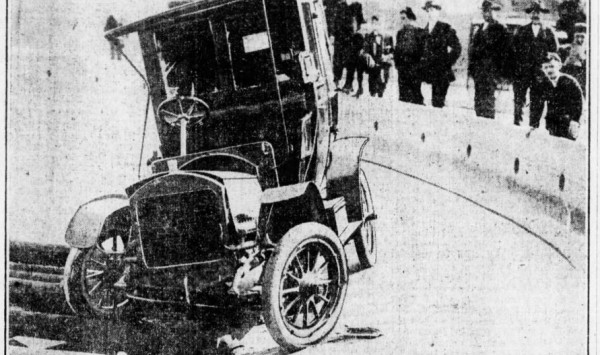
******************************************************************************************************************************** Brownstone Detectives investigates the history of our clients’ homes. The story you are about to read was composed from research conducted in the course of one of those investigations. Do you know the history of YOUR house? ******************************************************************************************************************************** When Brooklyn woke up one April morning in 1909, there in Prospect Park Plaza’s “Electric Fountain” sat a little blue taxicab. To many, the thing appeared as though it had always belonged there. Some wondered whether they’d simply not noticed it all along. But others realized that something was wrong. Something was certainly wrong. THE CASE OF THE IMPETUOUS TAXICAB It seems as though the Grand Army Plaza has always had a fountain. But back when the plaza was called Prospect Park Plaza and it encompassed a larger amount of land, that fountain was much larger and took up much more space. The fountain was then what was called an “electric fountain,” and after it was installed it would attract people by the thousands each year when the lights and the water were turned on. One year, after the winter had passed and after the water was supposed to have filled the reservoir, with the jets darting, and the lights dancing, the fountain sat silent. So, as popular as the fountain was to Brooklyn, the reporters of the city had descended upon Parks Commissioner Kennedy about it’s inactivity. And in the midst of the hubbub – came the crash. HOW IT ALL CAME ABOUT It was 11:30 on a Sunday night […]
“PLAIN” GIRLS SHOULD GO TO COLLEGE (1911)
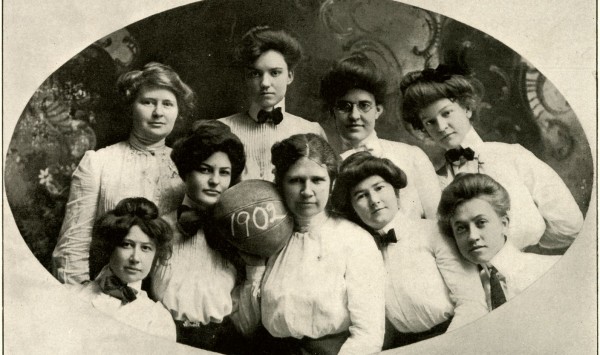
******************************************************************************************************************************** Brownstone Detectives investigates the history of our clients’ homes. The story you are about to read was composed from research conducted in the course of one of those investigations. Do you know the history of YOUR house? ******************************************************************************************************************************** It’s tough being plain. But if you go to college you increase your chances of getting that “MRS” degree. So said Brooklynite Imogene Kelly who, while in her senior year at Wellesley College in Massachusetts, was editor-in-chief of the school’s newspaper, Wellesley College News. The top scribe’s job gave the sensible young lady ample opportunity to place her thoughts before her adoring public. After her piece about the necessity of homely girls attending college to increase their chances of marital bliss, though, Kelly hadn’t much of an audience at all. WHY GIRLS GO TO COLLEGE In an article in the Brooklyn Daily Eagle, Kelly was showcased for her viewed of the necessity of a college education. “The unattractive girl, in order to equalize her chances for a husband with the less plain girl, must do so by getting an education,” Kelly reported. “The girl who is attractive and good looking need not secure a college training in order to fulfill her marriage destiny.” Kelly’s story, though, earned her an audience far beyond the campus of Wellesley, as it was picked up by a number of news services and printed in many places around the country. “The girls at Wellesley, as a rule, are not beautiful, and for that reason these girls […]
“DETECTIVES” HISTORY AUCTION NETS $1K

Brownstone Detectives created some history of its own last week. At the Prospect Park Alliance’s Party in the Park, the house detectives had the opportunity to join with Chris Bonnell, a brownstone illustrator, to contribute to the green non-profit organization’s annual silent auction. Bonnell donated a brownstone illustration to the auction, while Brownstone Detectives volunteered a House History Report. In the end, the team was the second-to-top auction grosser, raising $1000 for the Alliance’s activities. “It really excited the donors to get to bid on both the history and the illustration in the one offering,” said Brian Hartig, CEO of Brownstone Detectives. Bonnell, who recently received his MFA from the School of Visual Arts, has been drawing brownstones for some time now. A regular feature of the fundraiser’s silent auction every year, he thought that a team effort this year would create a more holistic approach to the documentation of a house. So he contacted Hartig – who agreed. “I’m looking forward to working with Chris on this project and others going forward,” said Hartig. “His drawings and our histories are going to make an excellent combination.” The two are planning to meet the winning bidder soon to start their work on drawing and researching her house. Follow @BrownstoneDetec ———————————————————————————————————————– The Brownstone Detectives The story you just read was composed from historical research performed by The Brownstone Detectives. Allow us do an in-depth investigation of your house and its former owners and produce your very own House History Book. Your hardbound […]
WIN A HOUSE HISTORY @ PROSPECT PARK!

Brownstone Detectives is giving away a free House History Report this week! We’ll be teaming up with architectural illustrator, Chris Bonnell, to help raise funds for the Prospect Park Alliance. The Alliance’s annual fundraiser Party for the Park – will be held at the Prospect Park Boathouse this Thursday, 14 May, at 8-11 p.m. Part of the fundraiser is a silent auction, where attendees can bid on donated products and services. There you will find our combined biddable auction – a House History Report and a House Illustration. HOUSE HISTORY REPORT – THE BROWNSTONE DETECTIVES If you are the lucky highest bidder on our auction, we will create your House History Report by researching and laying out your house’s chain of title, revealing the name of every person who owned your house, when they took ownership of it, and – wherever such information is available – how much they paid for it. In addition to the chain-of-title research, we will also perform historical research on the owners and on the house itelf. Most House History Reports run approximately 15-20 pages, detailing the historical lineage of your home in an engaging narrative. HOME ILLUSTRATION – CHRIS BONNELL Additionally, architectural illustrator, Chris Bonnell, will draw your house, capturing its personality and charming details in a high-quality digital print. Chris is a Brooklyn-based writer and illustrator, holding a BA in English from the University of Florida. Additionally, he is graduating this week from the School of Visual Arts with his MFA. Click HERE […]